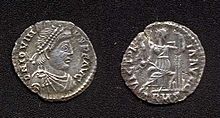
Honorius was Roman emperor from 393 to 423. He was the younger son of emperor Theodosius I and his first wife Aelia Flaccilla. After the death of Theodosius in 395, Honorius, under the regency of Stilicho, ruled the western half of the empire while his brother Arcadius ruled the eastern half. His reign over the Western Roman Empire was notably precarious and chaotic. In 410, Rome was sacked for the first time in almost 800 years.
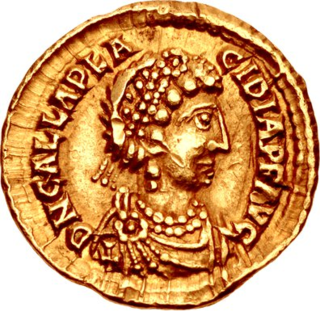
Galla Placidia, daughter of the Roman emperor Theodosius I, was a mother, tutor, and advisor to emperor Valentinian III. She was queen consort to Ataulf, king of the Visigoths from 414 until his death in 415, briefly empress consort to Constantius III in 421, and managed the government administration as a regent during the early reign of Valentinian III until her death.

Year 412 (CDXII) was a leap year starting on Monday of the Julian calendar. At the time, it was known in Europe as the Year of the Consulship of Honorius and Theodosius. The denomination 412 for this year has been used since the early medieval period, when the Anno Domini calendar era became the prevalent method in Europe for naming years.
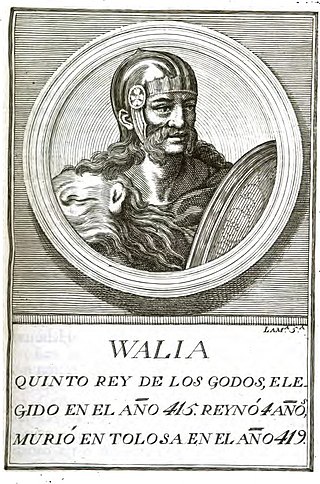
Year 415 (CDXV) was a common year starting on Friday of the Julian calendar. At the time, it was known as the Year of the Consulship of Honorius and Theodosius. The denomination 415 for this year has been used since the early medieval period, when the Anno Domini calendar era became the prevalent method in Europe for naming years.
The 410s decade ran from January 1, 410, to December 31, 419.

Year 411 (CDXI) was a common year starting on Sunday of the Julian calendar. At the time, it was known as the Year of the Consulship of Theodosius without colleague. The denomination 411 for this year has been used since the early medieval period, when the Anno Domini calendar era became the prevalent method in Europe for naming years.

Year 413 (CDXIII) was a common year starting on Wednesday of the Julian calendar. At the time, it was known as the Year of the Consulship of Herclianus and Lucius. The denomination 413 for this year has been used since the early medieval period, when the Anno Domini calendar era became the prevalent method in Europe for naming years.

Constantius III was briefly Western Roman emperor in 421. He earned his position as Emperor due to his capability as a general under Honorius, achieving the rank of magister militum by 411. That same year, he suppressed the revolt of Constantine III, a Roman general who had declared himself emperor. Constantius then went on to lead campaigns against various barbarian groups in Hispania and Gaul, recovering much of both for the Western Roman Empire. Constantius married Honorius's sister Galla Placidia in 417, a sign of his ascendant status, and was proclaimed co-emperor by Honorius on 8 February 421. He reigned for seven months before dying on 2 September 421.
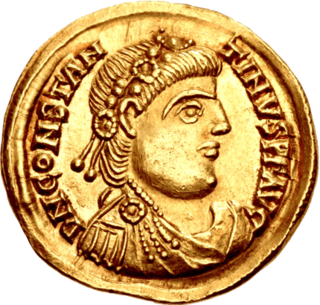
Constantine III was a common Roman soldier who was declared emperor in Roman Britain in 407 and established himself in Gaul. He was recognised as co-emperor of the Roman Empire from 409 until 411.

Athaulf was king of the Visigoths from 411 to 415. During his reign, he transformed the Visigothic state from a tribal kingdom to a major political power of Late Antiquity.

The term Western Roman Empire is used in modern historiography to refer to the western provinces of the Roman Empire, collectively, during any period in which they were administered separately from the eastern provinces by a separate, independent Imperial court. Particularly during the period from 395 to 476 AD, there were separate, coequal courts dividing the governance of the empire into the Western provinces and the Eastern provinces with a distinct imperial succession in the separate courts. The terms Western Roman Empire and Eastern Roman Empire were coined in modern times to describe political entities that were de facto independent; contemporary Romans did not consider the Empire to have been split into two empires but viewed it as a single polity governed by two imperial courts for administrative expediency. The Western Roman Empire collapsed in 476, and the Western imperial court in Ravenna was formally dissolved by Justinian I in 554 AD.
Constans II was caesar or heir apparent to his father Emperor Constantine III from 407 to 409 and co-emperor with Constantine and the Western Roman Emperor Honorius from 409 until his death. Constans was a monk prior to his father being acclaimed emperor by the army in Britain in early 407. Constans was summoned to the new imperial court, in Gaul, appointed to the position of Caesar and swiftly married so that a dynasty could be founded. In Hispania, Honorius's relatives rose in 408 and expelled Constantine's administration. An army under the generals Constans and Gerontius was sent to deal with this and Constantine's authority was re-established. Honorius acknowledged Constantine as co-emperor in early 409 and Constantine immediately raised Constans to the position of co-emperor, theoretically equal in rank to Honorius as well as to Constantine. Later in 409 Gerontius rebelled, proclaimed his client Maximus emperor and incited barbarian groups in Gaul to rise up. Constans was sent to quash the revolt, but was defeated and withdrew to Arles. In 410, Constans was sent to Hispania again. Gerontius had strengthened his army with barbarians and defeated Constans; the latter withdrew north and was defeated again and killed at Vienne early in 411. Gerontius then besieged Constantine in Arles.

This is a chronology of warfare between the Romans and various Germanic peoples between 113 BC and 476. The nature of these wars varied through time between Roman conquest, Germanic uprisings and later Germanic invasions of the Western Roman Empire that started in the late second century BC. The series of conflicts was one factor which led to the ultimate downfall of the Western Roman Empire in particular and ancient Rome in general in 476.

Sebastianus, a brother of Jovinus, was an aristocrat of southern Gaul. After Jovinus usurped the throne of the western Roman Emperor Honorius in Gaul in 411, he named Sebastianus as Augustus (co-emperor) in 412. Coins bearing Sebastianus' image were then minted at Arles and Trier.

The sack of Rome on 24 August 410 AD was undertaken by the Visigoths led by their king, Alaric. At that time, Rome was no longer the capital of the Western Roman Empire, having been replaced in that position first by Mediolanum in 286 and then by Ravenna in 402. Nevertheless, the city of Rome retained a paramount position as "the eternal city" and a spiritual center of the Empire. This was the first time in almost 800 years that Rome had fallen to a foreign enemy, and the sack was a major shock to contemporaries, friends and foes of the Empire alike.
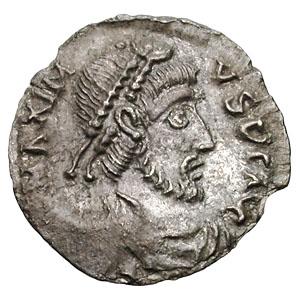
Maximus was a Roman usurper (409–411) in Hispania. He had been elected by general Gerontius, who might have been his father.
Goar was a leader of the Alans in 5th-century Gaul. Around the time that the Vandals and other Alans under Respendial crossed the Rhine in 405 or 406, Goar's band of Alans quickly joined the Romans, and subsequently played a role in the internal politics of Gaul.
Heraclianus was a provincial governor and a usurper of the Western Roman Empire (412–413) opposed to Emperor Honorius, who had originally brought him to power. Heraclianus helped put down a rebellion by Priscus Attalus. However, he decided to stage his own rebellion and during his invasion of the Italian peninsula, was either defeated in battle or captured and executed.
Sarus or Saurus was a Gothic chieftain, known as a particularly brave and skillful warrior. He became a commander for the emperor Honorius. He was known for his hostility to the prominent Gothic brothers-in-law Alaric I and Athaulf, and was the brother of Sigeric, who ruled the Goths briefly in 415.
